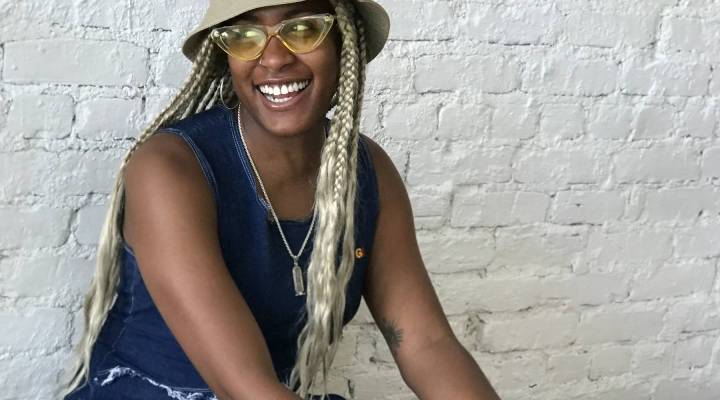
Navigating Instagram’s algorithm as @idealblackfemale

As an artist who uses Instagram as her primary platform, Mandy Harris Williams wants to know who is moderating content at Instagram and Facebook, Instagram’s parent company. They’ve been criticized of inaction where the flow of misinformation and hate speech on their platforms is concerned, though their removal of posts from right-wing conspiracy theorist and Infowars founder Alex Jones might indicate a step forward.
Facebook has also been criticized for the lack of diversity among its employees — in July, it reported that the percentage of black employees in technical roles remained flat in the last year, as did the percentage of black employees in leadership roles, at 1 percent and 2 percent respectively.
It worries Williams, who publishes “micro essays” on Instagram about race and beauty. The more followers she amasses, the harder time she’s had getting eyes on the content she posts with the hashtag #brownupyourfeed and as @idealblackfemale, and has felt plagued by shadow banning and censorship. She’s concerned that the algorithm and Instagram’s content managers either ignore or police her account. This experience is relevant to her writing, wherein she discusses how the images of bodies we see, specifically black womens’ bodies, help us determine what is acceptable, popular, desirable and deserving of attention.
She talked to Marketplace host Kai Ryssdal about her experience on the platform and what it’s like sharing the selfie-sphere with Kim Kardashian. The following is an edited transcript of their conversation.
Kai Ryssdal: You used to be a teacher … for a while, right?
Mandy Harris Williams: Yeah. Six years in kindergarten and first grade.
Ryssdal: And then you decided you needed another outlet, I guess.
Williams: Yeah, I was writing a lot, and I was not sharing it, and I didn’t really know how to or where I would. And the freelance pitching schedule is impossible to do alongside teaching.
Kai Ryssdal: And nightmarish nonetheless.
Williams: Yeah.
Ryssdal: One of my favorite quotes about you is you found the market for 30-page personal essays limited. Nowhere to put your stuff.
Williams: Yeah.
Ryssdal: Tell me about your art, then. What do you do?
Williams: I’ve been making artwork primarily about black female bodies — black women’s bodies, I really should say. And I’ve found a great home for it on Instagram. I’ve kind of taken on this format where I’ll use a photo or use an image and then write a micro essay, which is a lot easier to move than a 30-page essay, kind of attached to that image.
Ryssdal: Twitter and Facebook and Instagram can be hateful places. What do you do with that?
Williams: (sighs) I think the condition of being a woman of color is to be overpoliced and underprotected. So you have to work on two fronts within social media: You have to ask for the protection that you need and you have to ask for the guidelines of how your behavior is to be policed to be contextualized with respect to your identity and your history. So where the underprotection is concerned, you know, I’ll come across images. The other day I saw a disgusting image of Maxine Waters with some of the markers of what we might call blackface.
Ryssdal: African-American congresswoman from here in Los Angeles, we should say.
Williams: Right. For me, that felt very hateful. I think that’s something that content moderators need to be really aware of — the history, even, of what blackface looks like. What are the things that image makers, you know, 100 years ago were doing to black images to make them seem grotesque or unworthy or unlovable or unworthy of attention and respect? I think content moderators need to know that history and they need to be able to flag that. I reported that image and I asked many of my followers to report that image, and we were all met with the same response: that Instagram has looked at this image and we have deemed that it’s not hate speech.
Ryssdal: This is an inelegant segue, and one is not related to the other, but how do you do what you want to do when Kim Kardashian can put a selfie on Instagram and it explodes? Right?
Williams: Yeah, that’s a daunting question. I mean, you know, as a woman’s body, as a woman’s body ideal, Kim Kardashian has a lot of content and text, and every time she posts a selfie and there are millions of responses and millions of engagements, that says something about our culture and what we believe is valuable, what we believe is worthy of our attention. And so when I’m having the discussions about what is the “ideal black female” or what does it mean to present brownness on our feed or indigeneity on our feeds, I am, obviously, working within the context of the Kim Kardashian ideal and having to deconstruct that and speak to it.
Ryssdal: But in some ways it goes to the validity of your message, right?
Williams: I’d like to think so.
There’s a lot happening in the world. Through it all, Marketplace is here for you.
You rely on Marketplace to break down the world’s events and tell you how it affects you in a fact-based, approachable way. We rely on your financial support to keep making that possible.
Your donation today powers the independent journalism that you rely on. For just $5/month, you can help sustain Marketplace so we can keep reporting on the things that matter to you.












